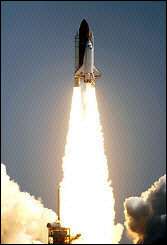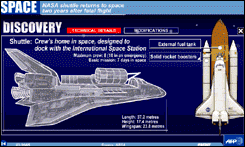Discovery blasted off (Update)

Discovery blasted off, taking seven astronauts on the first US shuttle mission since the Columbia disaster in 2003 that forced a complete rethink of the US space program.
It lifted off from its seaside Florida launching pad in a thunderous blast of smoke and fire, and arced through partly cloudy skies, leaving a huge trail of condensation.
Discovery reached orbit eight minutes and 40 seconds after liftoff from the Kennedy Space Center.
Two minutes after launch, Discovery's two solid fuel rocket boosters separated from the main orbiter, which also jettisoned its external fuel tank when it reached orbit, in what the US space agency called a picture-perfect start to the mission.
NASA managers heaved a sigh of relief at the successful launch that marks the first manned US space flight since the shuttle fleet was grounded after the Columbia disaster on February 1, 2003. A scheduled launch on July 13 was scrubbed because of a faulty fuel level sensor.
It was an emotional moment for the NASA experts and managers who had watched in horror as Columbia broke up in flames minutes from its scheduled return to Earth.
"Today mother nature smiled on us and I think the Columbia crew smiled on us," said Bill Readdy, NASA's assistant administrator for space operations.
Experts closely monitored Discovery's first two minutes of ascent, captured by more than 100 cameras on the ground and aboard two airplanes.
They focused particularly on the external tank's insulation that has been improved since a piece of foam detached itself from Columbia upon liftoff, causing a gash that allowed superheated gases to penetrate the orbiter when it reentered the Earth's atmosphere.
"This is a very difficult mission and there is still a lot of work in front of us," said space shuttle program manager Bill Parsons.
During the 12-day mission, the crew will perform some risky operations designed to test new safety procedures.
Once Discovery reached orbit, Collins tipped the shuttle slightly so the crew could see the external tank as it was jettisoned.
The unprecedented maneuver aimed at determining whether any insulating material fell off the massive tank at launch as was the case with Columbia.
NASA managers said they would need more time to analyze pictures that appear to show debris flying off the tank, but stressed it was not unusual for some material to come off the shuttle as it roars into space.

Once Discovery approaches the International Space Shuttle on Thursday, Commander Eileen Collins will flip the orbiter over, so the ISS crew can take photographs to help determine whether the shuttle's thermal protection system suffered any damage.
During the operation, Collins will briefly lose visual contact with the ISS, in a departure from NASA regulations for a docking approach.
During one of three planned spacewalks on the Discovery, Japanese mission specialist Soichi Noguchi and his US counterpart Stephen Robinson will test repair techniques adopted after the Columbia disaster.
They will test the use of toxic chemicals to repair the shuttle, but would abort the walk if the materials turn out to be too dangerous to handle in space.
The crew will also deliver supplies and equipment to the International Space Station.
NASA manager hailed what he called "the sheer gall, the pluckiness, the grittiness of this team that pulled this program out of the depths of despair two years and a half years ago and made it fly."
First Lady Laura Bush, who witnessed the launch, said it was "pretty terrific" that the mission commander is a woman.
The seven astronauts appeared upbeat. They smiled and waved as they boarded the shuttle, clad in their distinctive orange suits. Noguchi grinned as he held up a handwritten sign saying: "out to launch."
The National Aeronautics and Space Administration went ahead with the launch even though there was a risk that a fuel sensor which forced the earlier postponement could play up again.
The sensor is one of four that monitor hydrogen levels in the tank to prevent a premature shut off of the shuttle's three engines.
© 2005 AFP

















